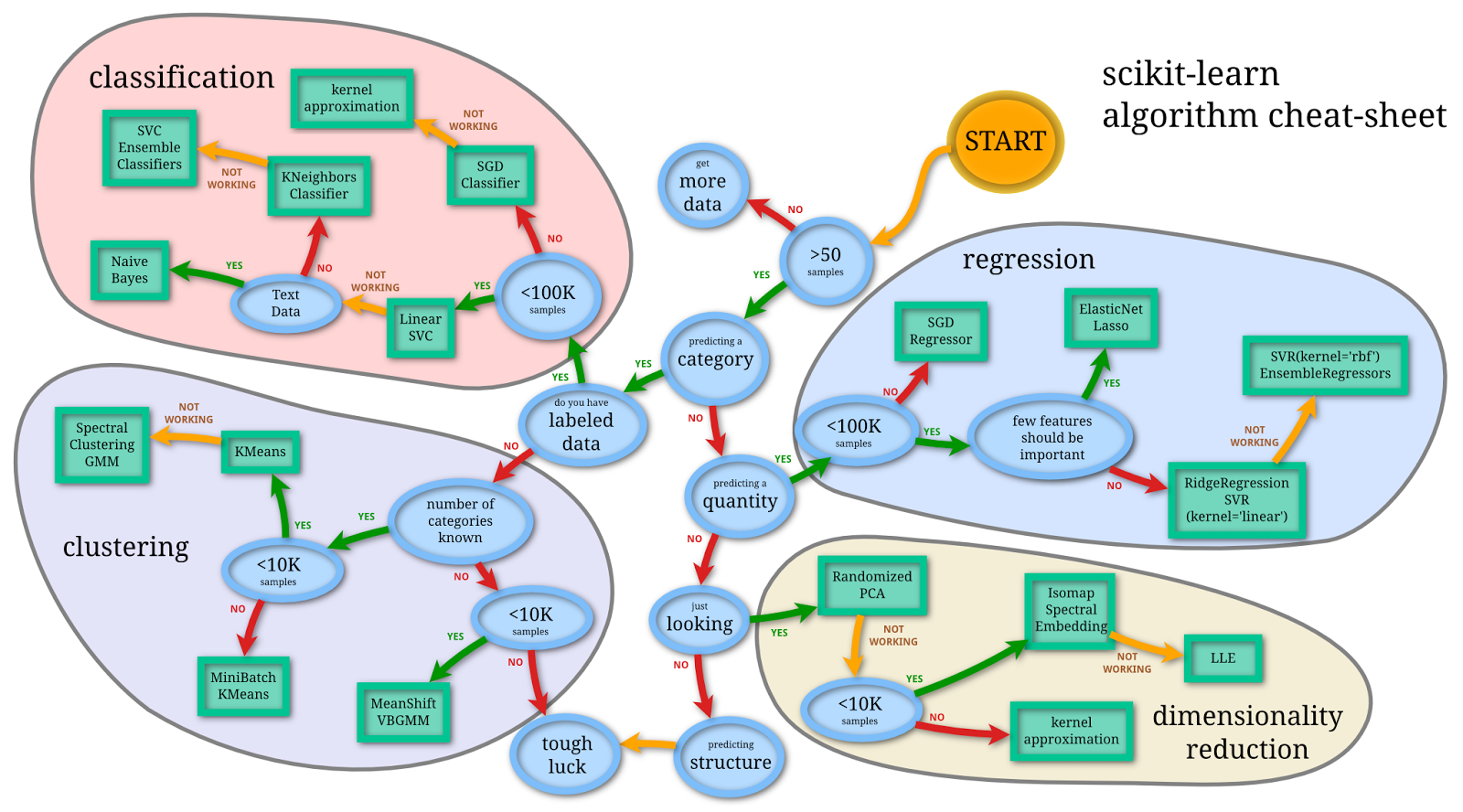
Machine Learning with scikit-learn
Andreas Mueller
Overview
- Basic concepts of machine learning
- Introduction to scikit-learn
- Some useful algorithms
- Selecting a model
- Working with text data
scikit-learn
- Collection of machine learning algorithms and tools in Python.
- BSD Licensed, used in academia and industry (Spotify, bit.ly, Evernote).
- ~20 core developers.
- Take pride in good code and documentation.
- We want YOU to participate!
Two (three) kinds of learning
- Supervised
- Unsupervised
- Reinforcement
Supervised learning
Training: Examples X_train together with labels y_train.
Testing: Given X_test, predict y_test.
Examples
- Classification (spam, sentiment analysis, ...)
- Regression (stocks, sales, ...)
- Ranking (retrieval, search, ...)
Unsupervised Learning
Examples X. Learn something about X.
Examples
- Dimensionality reduction
- Clustering
- Manifold learning

Data representation
Everything is a numpy array (or a scipy sparse matrix)!
Let's get some toy data.
from sklearn.datasets import load_digits
digits = load_digits()
print("images shape: %s" % str(digits.images.shape))
print("targets shape: %s" % str(digits.target.shape))
images shape: (1797, 8, 8) targets shape: (1797,)
plt.matshow(digits.images[0], cmap=plt.cm.Greys);
digits.target
array([0, 1, 2, ..., 8, 9, 8])
Prepare the data
digits.data = digits.data / 16.
X = digits.data.reshape(-1, 64)
print(X.shape)
(1797, 64)
y = digits.target
print(y.shape)
(1797,)
We have 1797 data points, each an 8x8 image -> 64 dimensional vector.
X.shape is always (n_samples, n_feature)
print(X)
[[ 0. 0. 0.3125 ..., 0. 0. 0. ] [ 0. 0. 0. ..., 0.625 0. 0. ] [ 0. 0. 0. ..., 1. 0.5625 0. ] ..., [ 0. 0. 0.0625 ..., 0.375 0. 0. ] [ 0. 0. 0.125 ..., 0.75 0. 0. ] [ 0. 0. 0.625 ..., 0.75 0.0625 0. ]]
Taking a Peek
Dimensionality Reduction and Manifold Learning
- Always first have a look at your data!
- Projecting to two dimensions is the easiest way.
Principal Component Analysis (PCA)
from sklearn.decomposition import PCA
Instantiate the model. Set parameters.
pca = PCA(n_components=2)
Fit the model.
pca.fit(X);
Apply the model. For embeddings / decompositions, this is transform.
X_pca = pca.transform(X)
X_pca.shape
(1797, 2)
plt.figsize(16, 10)
plt.scatter(X_pca[:, 0], X_pca[:, 1], c=y);
print(pca.mean_.shape)
print(pca.components_.shape)
(64,) (2, 64)
fix, ax = plt.subplots(1, 3)
ax[0].matshow(pca.mean_.reshape(8, 8), cmap=plt.cm.Greys)
ax[1].matshow(pca.components_[0, :].reshape(8, 8), cmap=plt.cm.Greys)
ax[2].matshow(pca.components_[1, :].reshape(8, 8), cmap=plt.cm.Greys);
Isomap
from sklearn.manifold import Isomap
Instantiate the model. Set parameters.
isomap = Isomap(n_components=2, n_neighbors=20)
Fit the model.
isomap.fit(X);
Apply the model.
X_isomap = isomap.transform(X)
X_isomap.shape
(1797, 2)
plt.scatter(X_isomap[:, 0], X_isomap[:, 1], c=y);
Classification
To evaluate the algorithm, split data into training and testing part.
from sklearn.cross_validation import train_test_split
X_train, X_test, y_train, y_test = train_test_split(X, y, random_state=0)
print("X_train shape: %s" % repr(X_train.shape))
print("y_train shape: %s" % repr(y_train.shape))
print("X_test shape: %s" % repr(X_test.shape))
print("y_test shape: %s" % repr(y_test.shape))
X_train shape: (1347, 64) y_train shape: (1347,) X_test shape: (450, 64) y_test shape: (450,)
Start Simple: Linear SVMs
from sklearn.svm import LinearSVC
Finds a linear separation between the classes.
Instantiate the model.
svm = LinearSVC()
Fit the model using the known labels.
svm.fit(X_train, y_train);
Apply the model. For supervised algorithms, this is predict.
svm.predict(X_train)
array([2, 8, 9, ..., 7, 7, 8])
Evaluate the model.
svm.score(X_train, y_train)
0.99257609502598365
svm.score(X_test, y_test)
0.96444444444444444
More complex: Random Forests
from sklearn.ensemble import RandomForestClassifier
Builds many randomized decision trees and averages their results.
Instantiate the model.
rf = RandomForestClassifier()
Fit the model.
rf.fit(X_train, y_train);
Evaluate.
rf.score(X_train, y_train)
0.99925760950259834
rf.score(X_test, y_test)
0.95111111111111113
Model Selection and Evaluation
Always keep a separate test set to the end.
- Measure performance using cross-validation
from sklearn.cross_validation import cross_val_score
scores = cross_val_score(rf, X_train, y_train, cv=5)
print("scores: %s mean: %f std: %f" % (str(scores), np.mean(scores), np.std(scores)))
scores: [ 0.95185185 0.94074074 0.93680297 0.95910781 0.92936803] mean: 0.943574 std: 0.010635
Maybe more trees will help?
rf2 = RandomForestClassifier(n_estimators=50)
scores = cross_val_score(rf2, X_train, y_train, cv=5)
print("scores: %s mean: %f std: %f" % (str(scores), np.mean(scores), np.std(scores)))
scores: [ 0.95555556 0.97407407 0.97026022 0.97769517 0.96282528] mean: 0.968082 std: 0.007970
Adjust important parameters using grid search
from sklearn.grid_search import GridSearchCV
- Let's look at LinearSVC again.
- Only important parameter: C
param_grid = {'C': 10. ** np.arange(-3, 4)}
grid_search = GridSearchCV(svm, param_grid=param_grid, cv=3, verbose=3, compute_training_score=True)
grid_search.fit(X_train, y_train);
[GridSearchCV] C=0.001 ......................................................... [GridSearchCV] ................................ C=0.001, score=0.902004 - 0.1s [GridSearchCV] C=0.001 ......................................................... [GridSearchCV] ................................ C=0.001, score=0.895323 - 0.1s [GridSearchCV] C=0.001 ......................................................... [GridSearchCV] ................................ C=0.001, score=0.879733 - 0.1s [GridSearchCV] C=0.01 .......................................................... [GridSearchCV] ................................. C=0.01, score=0.953229 - 0.1s [GridSearchCV] C=0.01 .......................................................... [GridSearchCV] ................................. C=0.01, score=0.937639 - 0.1s [GridSearchCV] C=0.01 .......................................................... [GridSearchCV] ................................. C=0.01, score=0.919822 - 0.1s [GridSearchCV] C=0.1 ........................................................... [GridSearchCV] .................................. C=0.1, score=0.973274 - 0.1s [GridSearchCV] C=0.1 ........................................................... [GridSearchCV] .................................. C=0.1, score=0.951002 - 0.1s [GridSearchCV] C=0.1 ........................................................... [GridSearchCV] .................................. C=0.1, score=0.951002 - 0.1s [GridSearchCV] C=1.0 ........................................................... [GridSearchCV] .................................. C=1.0, score=0.977728 - 0.2s [GridSearchCV] C=1.0 ........................................................... [GridSearchCV] .................................. C=1.0, score=0.957684 - 0.2s [GridSearchCV] C=1.0 ........................................................... [GridSearchCV] .................................. C=1.0, score=0.964365 - 0.2s [GridSearchCV] C=10.0 .......................................................... [GridSearchCV] ................................. C=10.0, score=0.975501 - 0.2s [GridSearchCV] C=10.0 .......................................................... [GridSearchCV] ................................. C=10.0, score=0.944321 - 0.2s [GridSearchCV] C=10.0 .......................................................... [GridSearchCV] ................................. C=10.0, score=0.962138 - 0.2s [GridSearchCV] C=100.0 ......................................................... [GridSearchCV] ................................ C=100.0, score=0.962138 - 0.2s [GridSearchCV] C=100.0 ......................................................... [GridSearchCV] ................................ C=100.0, score=0.935412 - 0.2s [GridSearchCV] C=100.0 ......................................................... [GridSearchCV] ................................ C=100.0, score=0.957684 - 0.2s [GridSearchCV] C=1000.0 ........................................................ [GridSearchCV] ............................... C=1000.0, score=0.964365 - 0.2s [GridSearchCV] C=1000.0 ........................................................ [GridSearchCV] ............................... C=1000.0, score=0.935412 - 0.2s [GridSearchCV] C=1000.0 ........................................................ [GridSearchCV] ............................... C=1000.0, score=0.957684 - 0.2s
[Parallel(n_jobs=1)]: Done 1 jobs | elapsed: 0.1s [Parallel(n_jobs=1)]: Done 21 out of 21 | elapsed: 3.2s finished
print(grid_search.best_params_)
print(grid_search.best_score_)
{'C': 1.0}
0.966592427617
plt.figsize(12, 6)
plt.plot([c.mean_validation_score for c in grid_search.cv_scores_], label="validation error")
plt.plot([c.mean_training_score for c in grid_search.cv_scores_], label="training error")
plt.xticks(np.arange(6), param_grid['C']); plt.xlabel("C"); plt.ylabel("Accuracy");plt.legend(loc='best');
Overfitting and Complexity Control
-
to the right: overfitting aka high variance.
- Means no generalization.
-
to the left: underfitting aka high bias.
- Means bad even on training set.
plt.plot([c.mean_validation_score for c in grid_search.cv_scores_], label="validation error")
plt.plot([c.mean_training_score for c in grid_search.cv_scores_], label="training error")
plt.xticks(np.arange(6), param_grid['C']); plt.xlabel("C"); plt.ylabel("Accuracy");plt.legend(loc='best');
Detecting Insults in Social Commentary
- My first (and only) kaggle entry.
- Classify short forum posts as insulting or not.
- A simple bag of word model carries quite far.
- Linear classifiers are usually the best for text data.
Read the CSV using Pandas (a bit overkill).
import pandas as pd
train_data = pd.read_csv("kaggle_insult/train.csv")
test_data = pd.read_csv("kaggle_insult/test_with_solutions.csv")
- The column "Insult" contains the target.
- The column "Comment" contains the text.
y_train = np.array(train_data.Insult)
comments_train = np.array(train_data.Comment)
print(comments_train.shape)
print(y_train.shape)
(3947,) (3947,)
print(comments_train[0])
print("Insult: %d" % y_train[0])
"You fuck your dad." Insult: 1
print(comments_train[5])
print("Insult: %d" % y_train[5])
"@SDL OK, but I would hope they'd sign him to a one-year contract to start with. Give him the chance to be reliable and productive, but give themselves the out if all his time off has hurt his playing skills or if he falls back into old habits." Insult: 0
Vectorizing the Data
from sklearn.feature_extraction.text import CountVectorizer
- Use bag of words model as implemented in CountVectorizer.
- Extracts a dictionary, then counts word occurences.
cv = CountVectorizer()
cv.fit(comments_train)
print(cv.get_feature_names()[:15])
[u'00', u'000', u'01', u'014', u'01k4wu4w', u'02', u'034', u'05', u'06', u'0612', u'07', u'075', u'08', u'09', u'0bama']
print(cv.get_feature_names()[1000:1015])
[u'argue', u'argued', u'arguement', u'arguements', u'arguing', u'argument', u'arguments', u'aries', u'aristocracy', u'aritculett', u'arizona', u'arkan', u'arlington', u'arm', u'armando']
X_train = cv.transform(comments_train).tocsr()
print("X_train.shape: %s" % str(X_train.shape))
print(X_train[0, :])
X_train.shape: (3947, 16469) (0, 3409) 1 (0, 5434) 1 (0, 16397) 1 (0, 16405) 1
Training a Classifier
- LinearSVC : linear SVM that is efficient for sparse data.
from sklearn.svm import LinearSVC
svm = LinearSVC()
svm.fit(X_train, y_train)
LinearSVC(C=1.0, class_weight=None, dual=True, fit_intercept=True,
intercept_scaling=1, loss='l2', multi_class='ovr', penalty='l2',
random_state=None, tol=0.0001, verbose=0)
comments_test = np.array(test_data.Comment)
y_test = np.array(test_data.Insult)
X_test = cv.transform(comments_test)
svm.score(X_test, y_test)
0.83037400831129582
print(comments_test[8])
print("Target: %d, prediction: %d" % (y_test[8], svm.predict(X_test.tocsr()[8])[0]))
"To engage in an intelligent debate with you is like debating to a retarded person. It's useless. It looks like you're bent on disregarding the efforts of the government." Target: 1, prediction: 1
Next Steps
- Grid search
Cparameter of LinearSVC.
- Build a pipeline, adjust parameters of feature extraction.
- Combine different feature extraction methods.
Take Away
- Get your data into an array
(n_samples, n_features).
- model.fit(X), model.predict(X) / model.transform(X)
- Always do cross-validation. Leave the test set until the end.
- Internalize the complexity / generalization tradeoff.
Fin
| amueller@ais.uni-bonn.de | |
| @t3kcit | |
 | @amueller |
| peekaboo-vision.blogspot.com |